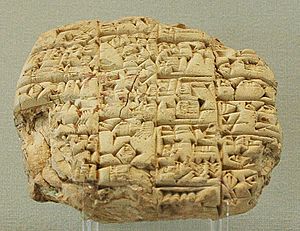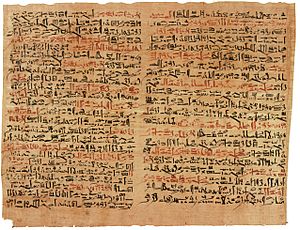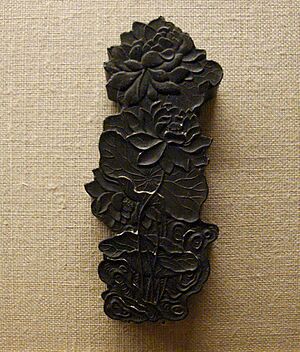Writing tool facts for kids
Writing tools are the things we use to write with. Today, most writing happens on a computer using special programs called word processors. But for thousands of years, people used much simpler tools. These tools were different depending on where people lived and what materials were available nearby.
Contents
Ancient Writing: The Middle East
The very first writing systems appeared in the Middle East. This area also saw the start of farming and the first cities. We don't know for sure which writing system came first, or if they influenced each other.
Sumer: Writing on Clay
The people of Sumer used clay as their main writing material. They created a writing style called cuneiform. To write, they pressed triangular marks into soft clay tablets. They used a tool made of metal or wood. After writing, the clay tablets dried in the sun or were baked. This made them hard so they could be carried and read later. We know that cuneiform was first used for trade, keeping records, and managing daily life.
Ancient Egypt: Hieroglyphs and Papyrus
Ancient Egyptian writing is very famous. It started around the same time as cuneiform but looked very different. Egyptians used various tools depending on what they were writing on. They even had three different ways to write the same language!
Writing on Stone: Hieroglyphs
Hieroglyphs are the well-known picture writing found on stone monuments. Scribes carved these hieroglyphs into stone using a hammer and chisel. They also painted them onto stone surfaces. Many of these carvings still exist today, some even with their original bright colors.
Writing on Papyrus: Reed Pens and Brushes
The Egyptians also used two faster writing styles: hieratic and demotic. They wrote these "running" scripts with reed pens and carbon inks onto papyrus. Papyrus was a paper-like material made from a plant. If they wrote on cloth, they used a brush instead of a pen. The reed pen was hollow and had a nib-like tip. This shows how people used local materials to create their writing tools.
Asian Writing: Brushes and Inksticks
The first Chinese writing system involved scratching lines onto bone or turtle shells. This happened between 1200 and 1500 BC.
Chinese Brushes and Ink
While Chinese characters can be written with many things, for a long time, they were written with a brush. The ink they used was made from carbon. Before use, the ink was shaped into a solid inkstick. This small, solid stick was easy to carry. To get liquid ink, the writer would grind the inkstick against a special inkstone with a little water. The earliest Chinese inks date back to the 12th century BC. They used burnt materials and plant dyes. Later, inks made from graphite were common. Even later, soot was used as the carbon source, and animal glue helped the ink stick to the paper. (Egyptian ink used gum arabic for the same reason.)
The Invention of Paper
Paper was a very important invention from China. The same writing tools and methods were later used in Japan and Korea, as these countries were influenced by China.
Roman Writing: Wax Tablets and Parchment
The Romans used lead styli (pointed tools) to write on wax tablets. These tablets could be "erased" by smoothing the beeswax surface again. For important, lasting records, they wrote on parchment. Parchment was treated animal skin. They also invented the idea of a book with pages sewn together. They called this a codex, which means something like 'block of wood'. Before the codex, long documents were kept as rolls.
The Evolution of Pens
For over a thousand years, people in Europe used dip-in pens.
Quill Pens
At first, these were quill pens made from the stiff stem of a pigeon feather. A knife was used to cut the quill's tip into a slanting nib. Quill pens were used from the Middle Ages until the early 1800s.
Metal Pens and Steel Nibs
Later, people tried making pens from metal. However, many metals were not flexible enough. The writing styles that developed with quill pens used both thick and thin lines. People wanted the same flexibility from metal pens. Between 1839 and 1849, the steel-nibbed pen solved this problem. For more than a century, factories produced hundreds of millions of steel nibs. A great advantage was that different types of nibs could be attached to the same pen holder. This allowed for various writing styles. Eventually, the best nibs had tips made of gold or iridium, a rare metal found in meteorites. Machines did all the steps in making these nibs.
The Secret of the Slit
The most important secret of all nibs, from the Egyptian reed pen to the steel pen, is the tiny slit down the middle of the tip. This slit guides the ink from a small pool under the nib to the very point where the ink touches the paper. Without this slit, a pen nib does not work well.
Images for kids
-
Writing tools from the 3rd-4th century found in Mtskheta, Georgia.







